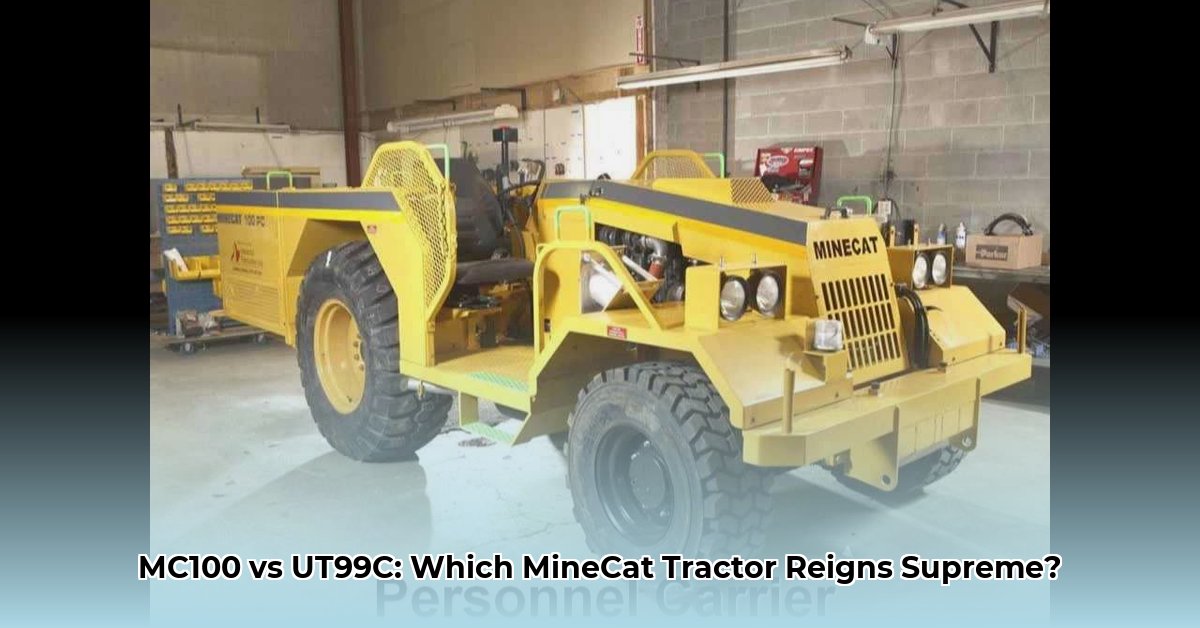
Choosing the right underground mining vehicle is a critical decision impacting safety, efficiency, and operational costs. This comparative review analyzes two popular MineCat tractors from Industrial Fabrication Inc.: the MC100 and the UT99C. We'll examine their strengths and weaknesses to help you determine which best suits your mining operation's needs. For additional resources on mining vehicles, check out this useful guide.
Two Tractors, Two Approaches
The MineCat MC100 and UT99C represent distinct approaches to underground mining transportation. Both boast robust ladder-type steel frames, simplifying maintenance. Safety features are standard across both models, including MSHA and Canmet-approved engines and all-wheel braking systems. Comfortable operator cabs and mine-safe wiring are standard, with optional ROPS (Rollover Protection Structures) and FOPS (Falling Object Protection Structures) available for enhanced safety. However, the UT99C's design is specifically optimized for the challenging environment of underground mines. Which design philosophy best aligns with your needs?
Customization and Specialization
The core difference lies in their approach to customization. The MC100 prioritizes versatility. It's a highly adaptable platform compatible with a wide range of attachments, allowing for customization to suit diverse tasks. Need heavy lifting? Add a loader. Long-distance material transport? An aerial boom or cable reel is an option. This adaptability, however, may come at a premium.
In contrast, the UT99C offers specialized pre-configured models. For example, personnel transport models are available with capacities from 2 to 10 people; this also includes maintenance vehicles such as lube trucks and service trucks, or even specialized models like mobile crane units. This specialization often translates to a quicker deployment and a potentially lower upfront investment compared to the extensive customization of the MC100. However, this built-in specialization comes with reduced adaptability to unusual tasks. What are the most frequent tasks at your mine site?
Cost Considerations: A Crucial Factor
A critical missing piece is comprehensive pricing information. While both MineCat models promise reduced operating costs, concrete data on total cost of ownership (TCO) is needed. This includes initial purchase price, ongoing maintenance, fuel consumption, and potential repair costs. This data is crucial for informed decision-making. Without these figures, a definitive comparison of long-term value remains impossible. How can we make an informed decision without access to complete cost information?
MC100 vs UT99C: A Feature Comparison
| Feature | MineCat Tractor MC100 | MineCat Tractor UT99C |
|---|---|---|
| Main Focus | Adaptability; wide range of attachments | Specialized configurations; personnel transport |
| Customization | Highly customizable; modular design | Pre-configured models; limited customization |
| Initial Cost | Data not available | Data not available |
| Operational Cost | Data not available | Data not available |
| Best Uses | Diverse tasks; high adaptability needed | Specific tasks; personnel transport prioritized |
Choosing the Right MineCat: A Practical Guide
The optimal MineCat tractor depends entirely on your specific operational needs.
Prioritizing Versatility: If your mine requires a highly adaptable machine for a variety of tasks, the MC100's modularity makes it a strong contender. However, this flexibility likely comes at a higher initial investment.
Focusing on Efficiency: If your work primarily involves predictable tasks such as personnel transport or specialized material handling, the UT99C's pre-configured designs might be more efficient and cost-effective in the long run. However, this reduced adaptability means it might not be suitable for unexpected situations. A thorough cost-benefit analysis is therefore vital.
What are your priorities: flexibility or specialized efficiency?
Long-Term Considerations and Future Outlook
Understanding the long-term reliability and cost implications of each model is paramount. Fleet standardization, using either the MC100 or a specific UT99C configuration, could simplify maintenance and parts management, creating economies of scale. Future developments from Industrial Fabrication Inc., leading to improvements in efficiency, emissions reduction and an expanded range of attachments, warrant attention. Furthermore, continued regulatory oversight to maintain safety is essential for the ongoing development of mining vehicle technology. What long-term maintenance strategies align with your operational goals?
How to Assess Total Cost of Ownership (TCO)
Before comparing the MC100 and UT99C, understanding TCO is vital. It extends beyond the initial purchase price, encompassing all expenses throughout the machine's lifespan: initial cost, fuel, maintenance, repairs, downtime, and eventual resale or disposal value. This holistic view is crucial for informed investment decisions. What metrics are crucial to build a TCO model for your mining operation?
This detailed comparison enables mine operators to navigate the complexities of choosing between the MineCat MC100 and UT99C, allowing for a more informed decision aligned with their specific operational requirements. The need for comprehensive cost data emphasizes the importance of requesting detailed cost breakdowns from the manufacturer and, where possible, conducting pilot programs to gather essential operational data. A clear understanding of these factors is essential for maximizing return on investment in mining equipment.